Disclosure: This post may contain affiliate links, meaning I get a commission if you decide to make a purchase through my links, at no extra cost to you.
A Jigsaw is a great tool for when you want to cut curves, and uneven shapes and do some rough cutting. But a Jigsaw is not the greatest tool for cutting clean, accurate cuts and often produces a lot of tear out. So how do we increase our chances of making clean and accurate cuts with a Jigsaw?
To make a clean and accurate cut with a jigsaw we want to use a T-shank jigsaw blade with varying thickness depending on the material, the orbital setting needs to be set to 0, use a guide for cutting straight cuts, secure the object you want to cut and let the tool do the cutting.
In this article, we will mainly focus on cutting wood with a jigsaw, but some of the tips and tricks will come in handy for cutting most materials.
1. Choose The Right Jigsaw Blade
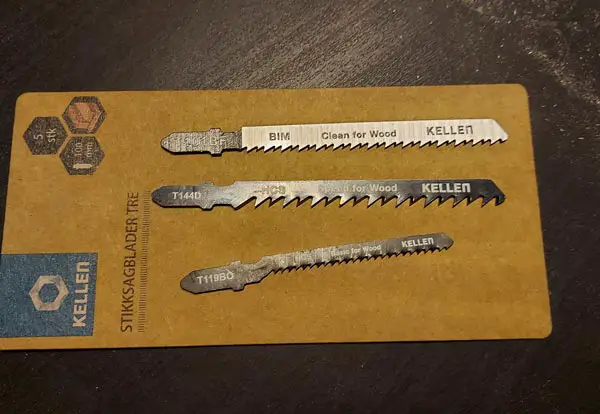
Jigsaw blades come in many different shapes and sizes. And most of the time they have a specific use. There is one for cutting metal, a different one for cutting wood fast, and another one for doing cleaner cuts in wood.
First of all, for doing cleaner cuts we want to use a T-shank blade. The T-shank blade is better secured and will vibrate less compared to a U-shank blade.
If your jigsaw only takes U-shank blades, you will just have to work with it.
The TPI(Tooth Per Inch) of the blade will depend on the thickness of the wood. A higher TPI will not always produce a cleaner cut, we need to find a good TPI compared to the thickness of the material.
When cutting wood that is thicker than 1-inch (2.5Cm) I recommend using a blade with a TPI between 6 – 10. If you have to force the tool through the wood, the blade will start cutting skewed which will make it impossible to make a clean cut.
For thinner pieces of wood, we can use blades with a TPI of 10 and up. A scrolling jigsaw blade is a great option for cutting thinner pieces of wood. Scrolling blades will often produce less tear out, a cleaner cut, and is great for cutting curves and tight radiuses.
The length of the blade also has to be longer than the thickness of the wood you are cutting. If it is not, then the Jigsaw will vibrate a lot while you are doing the cut.
To cut a 2-inch (5cm) thick piece of wood, it is best to have a jigsaw blade that is 3-inches (7.5cm)
Check Out The Ultimate Guide For Jigsaw Blades Here
2. Use A Guide
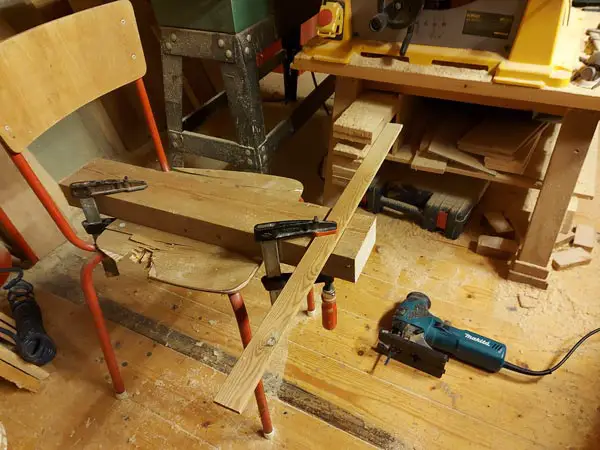
Most of the cutting we do with a jigsaw is freehand. The only guide we have is the Jigsaw blase that can rest on a flat surface and makes the blade cut perpendicular to the flat surface.
To cut a straight line with a jigsaw it is best to use a cutting guide. A simple DIY cutting guide/fence can be made with some clamps and a piece of wood that is squared.
How to make a DIY cutting guide:
- Mark the cut
- Mark the distance between the jigsaw blade to the edge of the jigsaw base
- Mark a second line the same distance as step 2
- Clamp down a squared wood piece at the second line to use as a fence.
- Clamp the object you want to cut to a flat surface
- Start cutting
I explain the cutting guide in more detail in this article.
3. Use A Quality Jigsaw
The quality of the Jigsaw will most of the time determine the quality of the cut you will be able to make. Now, it is possible to make a good cut with a cheap Jigsaw, but it is just so much simpler with a good Jigsaw.
Personally, I have a very cheap Jigsaw and a more expensive one. I have retired the lesser quality Jigsaw from any type of clean-cutting and fine woodworking. Now it is only used for cutting up firewood and pallets.
The problem with a poor-quality saw is that the motor is usually weaker. Hence you will have to use more force when cutting, which again will result in the blade changing course mid-cut.
I’m not saying that you have to have the absolute BEST jigsaw out there to make a clean cut. But having at least a good quality woodworking Jigsaw will help you a lot along the way.
A good quality mid-range Jigsaw is the Bosch JS470E (Amazon), this gives you the ability to make clean cuts with a little bit of practice.
4. Secure The Workpiece Properly
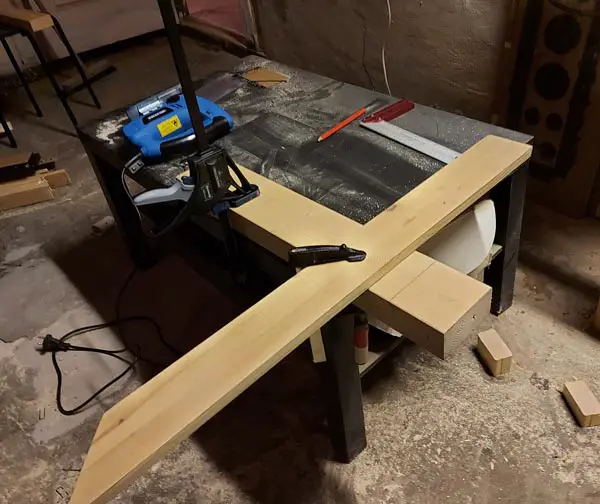
Securing the piece is crucial for making a clean cut with a jigsaw.
Clamp down the wood to a flat table or workbench to secure the workpiece. This is to ensure that the workpiece does not move while you are executing the cut.
A chair also works fine for securing the piece.
The fewer moving parts you have while cutting with a jigsaw, the better the cut will be.
5. Adjust the Orbital setting
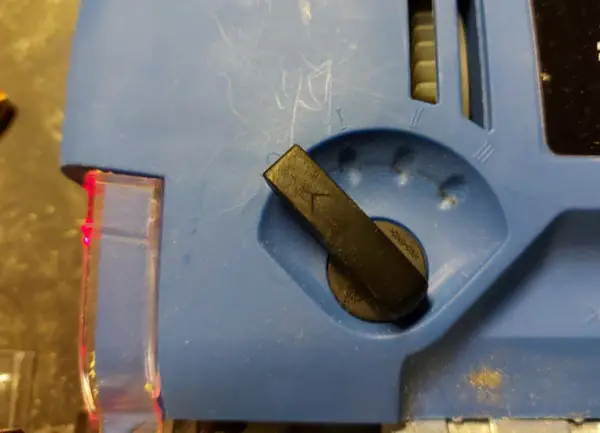
The orbital setting is one of the most crucial settings if you want to reduce wood tear-out and achieve a clean cut.
The orbital setting adjusts the cut angle of the blade, and with the orbital setting on, the blade cuts in more of a circular motion.
The orbital setting is usually a lever on the side of the Jigsaw that starts at 0 and maxes out at 3.
Setting the orbital setting to max (usually 3) will produce a cut with more tear-out of wood grain and a rougher cut in general. But the jigsaw will cut faster.
Setting the orbital setting to off (0) will produce a cleaner cut with less tear-out but the cut time will be longer.
6. Properly Mark The Material
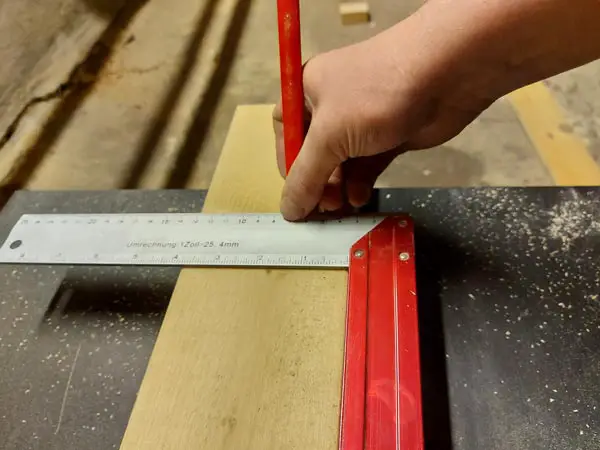
Make sure to make a strong visible mark for the cut.
When you start cutting, woodchips will reduce the visibility and it will be harder to see the line. Having a strong line will help you follow the line throughout the cut.
If you are marking a 90-degree cut on for example a 2X4 with a speed square, make sure that the material you are marking is actually squared off beforehand. Some lumber can have an uneven surface or be warped. Even if you bought it precut and milled from your local home center.
7. Let The Tool Do The Work
Don’t force the cut.
Forcing the cut will make the blade twist while cutting. This will result in an uneven cutting edge. The end of the wood piece will look more like a quarter pipe than a square if you force the cut too much.
The rate at which you can cut will vary from Jigsaw to Jigsaw and blade to blade. A blade with a lower TPI can cut faster than a blade with a higher TPI, and a more powerful jigsaw can cut faster than a weaker jigsaw.
How fast you make clean cuts with your setup will become second nature with some practice.
8. Use A Jigsaw Where You Can See The Blade During The Cut
I prefer using a Jigsaw where I can see the blade from the top while doing the cut. This makes it easier to follow the line without going off course.
Some jigsaws have so much equipment in the front that covers the blade so you do not see it when you are cutting.
These Jigsaws usually use a laser guide instead. But even if you follow the laser guide during the cut it can still become skewed due to the tension on the blade. And the cut will end up twisted.
It is good to have that direct visual feedback on the blade cutting.
9. Tape The Cut
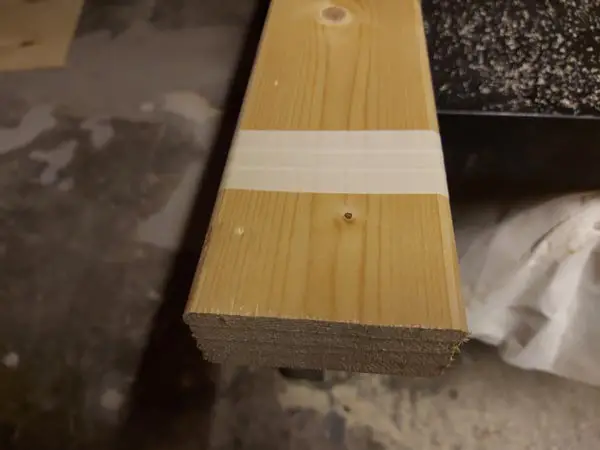
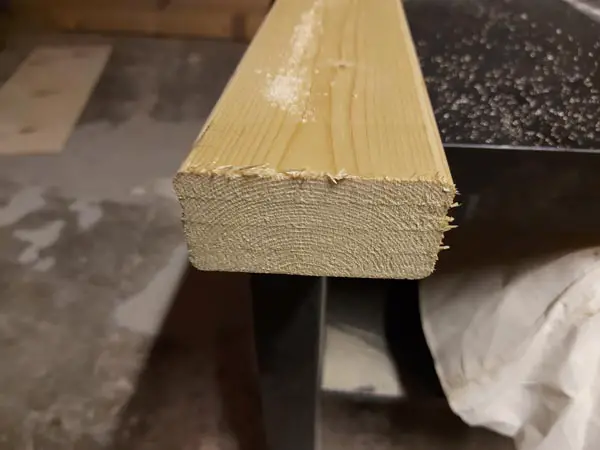
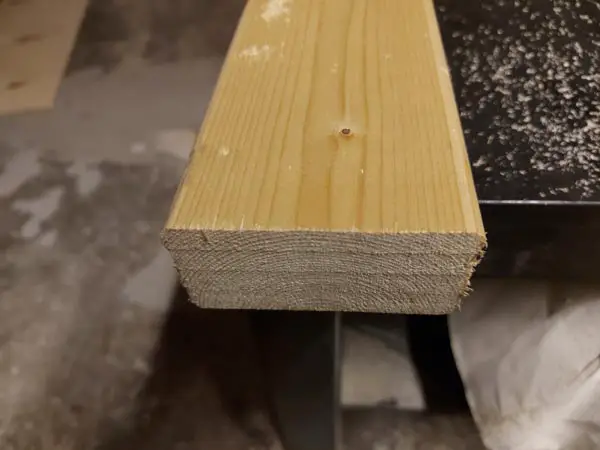
As you can see above, taping the cut area with masking tape before cutting will reduce the amount of tear-out. I used a rough wood blade and a high orbital setting for both cuts.
Since the jigsaw usually cuts on the upstroke it will produce the most tear-out of wood fibers on the surface facing you.
To reduce the tear-out you can cover the cut area with some masking tape. This will hold the wood fibers together and produce a cleaner edge.
But make sure to mark the cutting line after you have applied the tape.
10. Use A blade That Cuts On The Downstroke
In some situations, it might be suitable to use a jigsaw blade that cuts on the downstroke instead of the upstroke.
Using a downstroke blade will produce the tear-out on the surface that is facing away from the cut. So if you really need the facing surface to have no tear-out and have a clean edge, using upstrokes blades can be helpful.
The downside of using a downstroke blade is that the blade is pushing away from the cutting surface while cutting. This creates more vibration while cutting and the jigsaw is harder to control.
The downstroke blade pushes away the jigsaw from the surface you are cutting.
The upstroke blade pulls in the jigsaw to the surface you are cutting.
11. Cut close to the line
You do not always have to follow the line to the point. You can cut close to the line and clean it up with a sanding tool afterward and sneak up on the line.
Just make sure that you are making the cut on the right side of the line.
12. Practice, Practice, Practice
Jigsaws are one of the simplest tools to pick up and start making cuts with. But it can also be very hard to achieve a clean cut with a jigsaw.
Like with any other tool, you will need to practice to get the results you want with a jigsaw.
The best way to get good at using a jigsaw is to use it, a lot.
Try different types of blades, set the orbital setting to the max, set the orbital setting to 0, and try cutting a thick piece of wood and a thinner piece of wood, use a cheap jigsaw and try a more expensive jigsaw if you can get your hands on one.
I hope that this article gave some insight into the different aspects of making clean cuts with a jigsaw and helped you on your journey as a woodworker.
Make sure to stay safe, we are working with power tools here that can cause damage if not used right, you are in charge of your own safety.
